Foreign Sugar Prices Are a Sweet Deal for Confectioners San Antonio ExpressNews
Post on: 24 Июль, 2015 No Comment

Recent Headlines
For companies in the candy-making business, low sugar prices overseas are making it more attractive to move their manufacturing facilities out of the U.S. Countries like Malaysia and Guatemala are benefiting from new factories being opened by smaller candy makers, as they look for new ways to stay in business. The move has allowed them to maintain competitive prices on their products that large retailers are more willing to pay.
As a result, their businesses have been less affected by the price of U.S. sugar vs. foreign sugar. U.S. sugar has cost around twice as much on average during the past 12 years. According to U.S. Census data graphed by the Wall Street Journal. in 2010 world sugar prices hovered at about $0.15/pound, while U.S. sugar traded at close to $0.30/pound. Current prices show a narrower price gap, with the world price for sugar at around $0.195 and a domestic price of $0.223 .
The U.S. federal government’s price floor for sugar guarantees the sugar industry a minimum profit, about $0.21/pound. This is putting U.S. candy makers at a disadvantage due to a high producing sugar crop from foreign growers, like Brazil, and declining world prices. Factoring in other rising operational costs, such as salary and wages, utilities, and packaging, the move of production facilities to a foreign country becomes even more attractive. With the U.S. government’s price supports on sugar not expected to change, are major confectioners also switching to overseas manufacturing?
Hershey keeps its chocolate-making plant in the U.S .
For Hershey . sugar is listed second, after cocoa products, among its list of significant raw material requirements. Hershey states in its 2012 annual report that it uses hedging and forward contracts to stabilize the prices it pays for commodities. These contracts protect the company from future commodity price increases, but also limit its ability to take advantage of price drops .
Hershey’s main chocolate-making facility is being transitioned to a new facility in West Hershey, Pennsylvania. In October 2013, the company announced it would be investing $250 million in the construction of a new confectionery manufacturing plant in Malaysia. The plant is aimed at meeting increasing demand in the Asian market. It will also complement production from an existing joint venture manufacturing plant located in China.
With manufacturing facilities in Canada, Mexico, India, and Brazil , Hershey is also opening a new Asia Innovation Center in Shanghai, China. This center will develop, test, and launch new products for consumers in China and the rest of the Asia region. The center was created to support the company’s fastest growth market .
Tootsie Roll focused on being a low cost producer
Similar to Hershey, Tootsie Roll Industries employs hedging and purchases forward contracts to protect the company from commodity cost increases. During 2012, the company noted that greater supplies of sugar led to lower prices that were offset by rising costs of corn-based sweeteners due to drought conditions in the Midwest. It was noted that higher prices were used to recover rising input costs, which put at risk the resulting sales volume of its products.
The company is focused on being a low cost producer in each of its major product lines . While the company doesn’t show signs of moving its domestic operations overseas, the threats of future rising costs and competitive pressure could sway it to look overseas for more cost effective manufacturing options.
In the latest quarterly report, Tootsie Roll’s sales were off on a comparative basis. The company is focused on restoring its margins to historical levels, as it deals with rising ingredient and other input costs .
Mondelez redesigns supply chain to improve productivity
Mondelez International announced in September that the company is embarking on a major overhaul of its supply chain. The redesign is expected to deliver $1.5 billion in net productivity over the next three years and $1 billion in additional cash. The savings are expected to improve operating margin by 60-to-90 basis points. The company is also increasing investments in emerging markets to achieve long-term growth and plans to pay for them via expanding margins in North America and Europe .

During 2012 the company experienced higher commodity costs, and price volatility continued into 2013. Like its competitors, Mondelez addresses increasing commodity costs by raising product prices, lowering direct manufacturing costs and controlling overhead. It does not fully hedge against changing commodity prices, which leaves the company vulnerable to price increases but may make it easier to take advantage of drops in market price .
My Foolish conclusion
All of these companies’ product sales are affected by higher commodity prices. With sugar as a key ingredient in their products, its price will have a major impact on the costs they pay for raw materials. With a future U.S. sugar policy that is unlikely to change, looking abroad for more favorable manufacturing conditions is an obvious choice.
Hershey serves as an example of a major candy maker with a main facility located in the U.S. and key investments in overseas manufacturing. As smaller competitors move abroad to stay in business, these larger confectioners may find the benefits of manufacturing their products overseas hard to resist.
The market stormed out to huge gains across 2013, leaving investors on the sidelines burned. However, opportunistic investors can still find huge winners. The Motley Fool’s chief investment officer has hand-picked one such opportunity in our new report: The Motley Fool’s Top Stock for 2013 . To find out which stock it is and read our in-depth report, simply click here. It’s free!
Eileen Rojas has no position in any stocks mentioned. The Motley Fool has no position in any of the stocks mentioned. Try any of our Foolish newsletter services free for 30 days. We Fools may not all hold the same opinions, but we all believe that considering a diverse range of insights makes us better investors. The Motley Fool has a disclosure policy .
Copyright © 1995 — 2013 The Motley Fool, LLC. All rights reserved. The Motley Fool has a disclosure policy .














